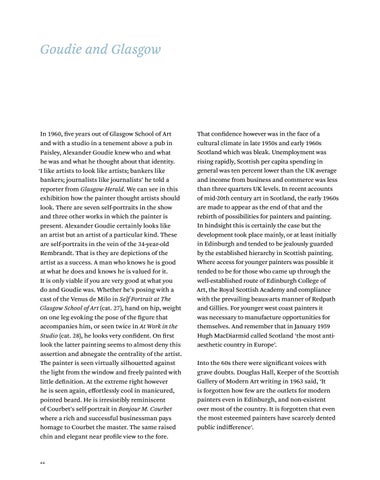Goudie and Glasgow
In 1960, five years out of Glasgow School of Art and with a studio in a tenement above a pub in Paisley, Alexander Goudie knew who and what he was and what he thought about that identity. ‘I like artists to look like artists; bankers like bankers; journalists like journalists’ he told a reporter from Glasgow Herald. We can see in this exhibition how the painter thought artists should look. There are seven self-portraits in the show and three other works in which the painter is present. Alexander Goudie certainly looks like an artist but an artist of a particular kind. These are self-portraits in the vein of the 34-year-old Rembrandt. That is they are depictions of the artist as a success. A man who knows he is good at what he does and knows he is valued for it. It is only viable if you are very good at what you do and Goudie was. Whether he’s posing with a cast of the Venus de Milo in Self Portrait at The Glasgow School of Art (cat. 27), hand on hip, weight on one leg evoking the pose of the figure that accompanies him, or seen twice in At Work in the Studio (cat. 28), he looks very confident. On first look the latter painting seems to almost deny this assertion and abnegate the centrality of the artist. The painter is seen virtually silhouetted against the light from the window and freely painted with little definition. At the extreme right however he is seen again, effortlessly cool in manicured, pointed beard. He is irresistibly reminiscent of Courbet’s self-portrait in Bonjour M. Courbet where a rich and successful businessman pays homage to Courbet the master. The same raised chin and elegant near profile view to the fore.
46
That confidence however was in the face of a cultural climate in late 1950s and early 1960s Scotland which was bleak. Unemployment was rising rapidly, Scottish per capita spending in general was ten percent lower than the UK average and income from business and commerce was less than three quarters UK levels. In recent accounts of mid-20th century art in Scotland, the early 1960s are made to appear as the end of that and the rebirth of possibilities for painters and painting. In hindsight this is certainly the case but the development took place mainly, or at least initially in Edinburgh and tended to be jealously guarded by the established hierarchy in Scottish painting. Where access for younger painters was possible it tended to be for those who came up through the well-established route of Edinburgh College of Art, the Royal Scottish Academy and compliance with the prevailing beaux-arts manner of Redpath and Gillies. For younger west coast painters it was necessary to manufacture opportunities for themselves. And remember that in January 1959 Hugh MacDiarmid called Scotland ‘the most antiaesthetic country in Europe’. Into the 60s there were significant voices with grave doubts. Douglas Hall, Keeper of the Scottish Gallery of Modern Art writing in 1963 said, ‘It is forgotten how few are the outlets for modern painters even in Edinburgh, and non-existent over most of the country. It is forgotten that even the most esteemed painters have scarcely dented public indifference’.







